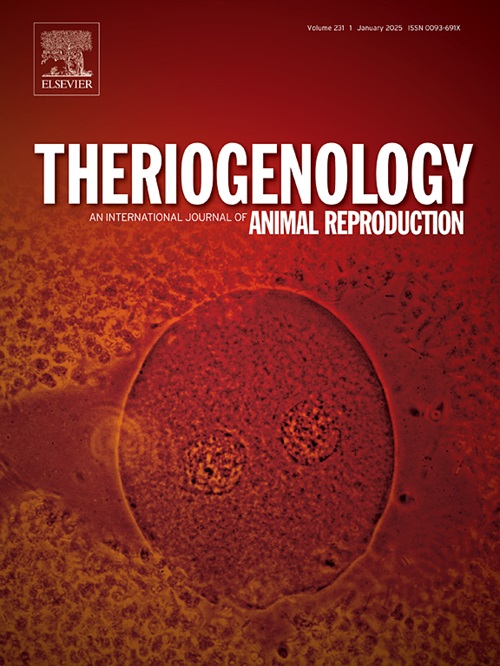补充普氏原氨酸可提高体外生产的牛胚胎的发育能力。
IF 2.4
2区 农林科学
Q3 REPRODUCTIVE BIOLOGY
引用次数: 0
摘要
本研究的目的是通过在体外培养基中添加抗凋亡、抗氧化和促进细胞增殖的腐胺,研究腐胺对胚胎发育和质量的影响。在这项研究中,卵母细胞取自荷斯坦牛的卵巢。成熟和受精后,推定的合子被随机分配到两组。第一组(Putrescine,n = 435)在体外培养时补充浓度为 0.5 mM 的腐胺。第二组(n = 407)在标准培养条件下进行培养,不添加任何培养基。在确定胚胎的发育阶段后,只对处于囊胚期的胚胎进行差异染色,并确定胚胎的细胞数。此外,还采用了 TUNEL 检测法来确定胚胎的细胞死亡程度和凋亡指数。此外,还测定了胚胎中 ROS 的水平。此外,还对囊胚期胚胎进行了基因表达分析,以确定在胚胎发育过程中补充腐胺在特定途径上的潜力。体外培养后,石灰华组的囊胚形成率为 44.37%,对照组为 32.97%(P本文章由计算机程序翻译,如有差异,请以英文原文为准。
Putrescine supplementation improves the developmental competence of in vitro produced bovine embryos
The aim of this study was to investigate the effect of putrescine, anti-apoptotic, antioxidant, and a cell proliferation stimulant, on embryo development and quality by supplementing it to in vitro culture medium. In this study, oocytes were obtained from the ovaries of Holstein cattle. Following maturation and fertilization, the presumptive zygotes were randomly assigned to two groups. The first group (Putrescine, n = 435) was supplemented with putrescine at a concentration of 0.5 mM to in vitro culture. The second group (n = 407) was maintained under standard culture conditions without any supplementations to the medium. Following the determination of the developmental stages of the embryos, only those in the blastocyst stage were subjected to differential staining and the cell numbers of the embryos were determined. Moreover, the TUNEL assay was employed to ascertain the extent of cell death and the apoptotic index in the embryos. Additionally, the levels of ROS were determined in the embryos. Furthermore, gene expression analyses were conducted on blastocyst-stage embryos to ascertain the potential of putrescine supplementation in embryo development along specific pathways. Following in vitro culture, the blastocyst formation rate was 44.37 % in the putrescine group and 32.97 % in the control group (P < 0.05). The counts of ICM (60.60 ± 15.79 vs 50.73 ± 16.74), TE (117.70 ± 23.67 vs 94.0 ± 22.46), and TCC (178.30 ± 26.15 vs 144.73 ± 26.86) were found to be statistically higher in blastocysts developing after putrescine supplementation compared to the control group. Furthermore, the number of apoptotic cells (7.69 ± 2.17 vs 9.96 ± 3.99) and the apoptotic index (5.07 % vs 8.01 %) were found to be lower in the putrescine group in comparison to the control group. Nevertheless, it was established that the ROS level in the control group was approximately two-fold higher than in the putrescine group (P < 0.05). The findings also revealed that putrescine up-regulated the gene expression of SOD, GPX4, CAT, BCL2, NANOG and GATA3 while simultaneously down-regulating the BAX expression level. In conclusion, the supplementation of putrescine to the culture medium during in vitro bovine embryo production was found to contribute to the improvement of embryo quality and early embryonic development.
求助全文
通过发布文献求助,成功后即可免费获取论文全文。
去求助
来源期刊

Theriogenology
农林科学-生殖生物学
CiteScore
5.50
自引率
14.30%
发文量
387
审稿时长
72 days
期刊介绍:
Theriogenology provides an international forum for researchers, clinicians, and industry professionals in animal reproductive biology. This acclaimed journal publishes articles on a wide range of topics in reproductive and developmental biology, of domestic mammal, avian, and aquatic species as well as wild species which are the object of veterinary care in research or conservation programs.
 求助内容:
求助内容: 应助结果提醒方式:
应助结果提醒方式:


